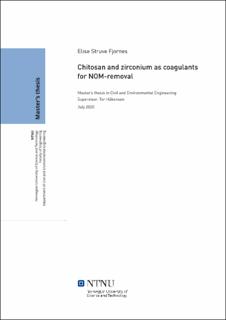| dc.contributor.advisor | Håkonsen, Tor | |
| dc.contributor.advisor | Meyn, Thomas | |
| dc.contributor.author | Fjornes, Elise Struve | |
| dc.date.accessioned | 2021-09-20T16:22:51Z | |
| dc.date.available | 2021-09-20T16:22:51Z | |
| dc.date.issued | 2020 | |
| dc.identifier | no.ntnu:inspera:59875849:35323627 | |
| dc.identifier.uri | https://hdl.handle.net/11250/2779489 | |
| dc.description.abstract | For denne oppgave var følgende forskerspørsmål stilt:
Hvordan fungerer de alternative koagulantene, kitosan og zirkonium, sammenlignet med tradisjonelle koagulanter, spesielt når det gjelder å fjerne NOM?
Denne oppgaven er basert på eksperimenter med Jar-tester for forskjellige koagulasjonstyper. To råvannskilder ble brukt i forsøkene, den ene fra Vennatjønna i Malvik og den andre fra Stakkastadvatnet i Haugesund. Vannet fra Malvik hadde høy farge på 56 mg Pt / l og hovedfraksjonen var humus på 79%. Vannet fra Haugesund hadde en fargeverdi på 31 mg Pt / l, og også humus som den største fraksjonen på 74%.
Hovedintensjonen ved oppgaven er å evaluere for fjerning av naturlig organisk materiale (NOM). NOM kan føre til potensiell biologisk vekst og redusere virkningen av desinfeksjon. Derfor er det viktig å fjerne NOM. Målinger av parametere farge, turbiditet, DOC, TOC og UV254 har vært utført. For noen utvalgte prøver ble fraksjonering av vannet utført ved hjelp av en LO-OCD-måling. Koagulantene som ble testet var kitosan og zirkonium, som ble vurder opp mot den godt studerte polyaluminumklorid (PACI).
Testene ble delt inn i fire deler. Den første delen besto av å finne optimal pH og dosering for de to koagulantene. PACl er en godt studert og brukt koagulant, og videre optimaliseringstester for den ble ikke gjort. En annen, ny og lite brukt polymer, mikrobiell ekstracellulær polymere substanser (EPS), ble også undersøkt. Den andre delen besto av å evaluere for fjerning av NOM. Beregnede SUVA-verdier er inkludert her.. I tredje del ble vannet fra Malvik tynnet ut, for å evaluere kitosan ved lavere råvannsfargeverdier. Bare kitosan ble evaluert i denne delen. Den siste delen inneholdt vannet fra Haugesund, der kitosan og zirkonium ble testet på egen hånd og deretter kombinert. Haugesund kommune bruker en kombinert koagulering av zirkonium og kitosan som behandling i dag. En prøve av denne kombinasjonen ble gitt for å bli testet, og forskjellige doser av denne kombinasjonen ble også undersøkt.
Optimal dosering for kitosan i Malvik var 7 - 12 mg / l med en pH på 5 -5.5. Zirkonium hadde et optimalt doseringsområde på 4 - 10 med en pH på 4.5 – 5.5. De tre koagulantene oppnådde alle NOM-fjerning, hvor Zirconium og PACl oppnådde litt høyere fjerning enn kitosan, men kitosan oppnådde resultater som indikerte fjerning av NOM innenfor grensen. EPS viste veldig liten reduksjon i både farge, turbiditet og DOC. Koagulanten egner seg bedre for andre vanntyper. Testen med vann fra Haugesund viste at zirkonium og de kombinerte koagulantene presterte bedre enn kitosan alene, men kitosan oppnådde gode resultater og beviste sine evner for å behandle vannet. | |
| dc.description.abstract | The main research question for this thesis are:
How does alternative coagulants, chitosan and zirconium, perform compared to traditional coagulants, especially in terms of removing NOM?
This thesis is based on experiments using Jar tests for different coagulation types. Two sources of raw water where utilized in the experiments, one from Vennatjønna in Malvik and the other from Stakkastadvatnet in Haugesund. The water from Malvik had high color of 56 mg Pt/l and the main fraction where humics at 79 %. The water from Haugesund had a color value of 31 mg Pt/l, and also humics as the largest fraction at 74 %.
The main intention where to evaluate for removal of Natural Organic Matter (NOM). NOM can lead to potential biological growth and reduce the impact of disinfection. Therefore, removing NOM are of high importance. Measurements of parameters color, turbidity, DOC, TOC and UV254 where conducted. For some selected samples, fractionation of the water where conducted using a LO-OCD measurements. The coagulants tested where chitosan and zirconium, and evaluated against the well studied polyaluminumchloride (PACl).
The tests were divided into four parts. The first part consisted of finding the optimum pH and dosage for the two coagulants. PACl is a well-studied and used coagulants, and further optimization test where not done. Another, new and little used polymer, microbial extracellular polymeric substances (EPS), where investigated as well. The second part consisted of evaluating for NOM removal. Calculated SUVA values where included here. In the third part, the water from Malvik were thinned out, in order to evaluate chitosan at lower raw water color values. Only chitosan was evaluated in this part. The last part contained the water from Haugesund, where chitosan and zirconium where tested on their own and then combined. Haugesund municipality utilize a combined coagulation of zirconium and chitosan as treatment today. A sample of this combination where given to be tested, and different dosage of this combination were investigated as well.
Optimum dosage for chitosan in Malvik where 7 – 12 mg/l with a pH of 5 -5.5 Zirconium had a optimum dosage range of 4- 10 with a pH of 4.5 – 5.5.The three coagulants all obtained NOM removal, where Zirconium and PACl achieved slightly higher removal than chitosan, but chitosan did obtain results indicating NOM removal within limit. EPS showed very little reduction in either color, turbidity and DOC. The coagulant are better suited for other water types. The test with water from Haugesund showed that zirconium and the combined coagulants performed better than chitosan alone, but chitosan obtained good results and proven its capabilities for treating the water. | |
| dc.language | | |
| dc.publisher | NTNU | |
| dc.title | Chitosan and zirconium as coagulants for NOM-removal | |
| dc.type | Master thesis | |
